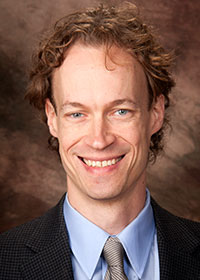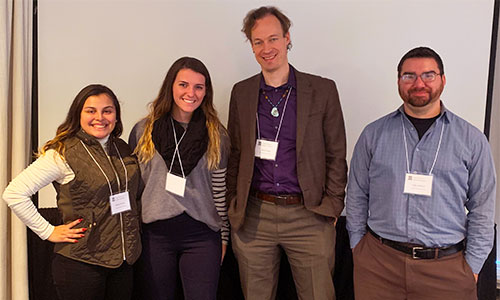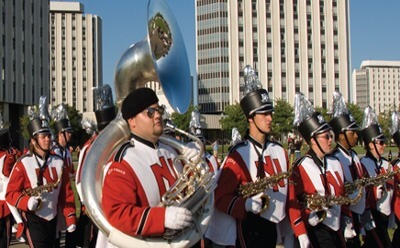
Talking about race is never easy.
Secondary teaching candidates in NIU’s EPS 450: Classroom Management course, however, are growing more comfortable in conducting such discussions in respectful, productive ways – something their professor hopes will “change the conversation.”
Daryl Dugas, an assistant professor in the Department of Leadership, Educational Psychology and Foundations, led his students this past spring through a unit on Culturally Responsive Classroom Management helping them to not only recognize their own racial biases but to share openly what they discover about themselves.
“A lot of people have these conversations about race and equity, but they just go nowhere or backfire because people retreat to their own corners or get quiet. People are worried about offending people, or about being called racist,” Dugas says.
“And then on the flip side, people can say insensitive or hurtful things, and they don’t know they’re being hurtful,” he adds, “and then people just get angry at each other and no real sharing can happen.”
Self-awareness is the key, he says, especially for teachers hoping to make a positive difference or to disrupt the “school-to-prison pipeline” caused by disparate punishment of black and Latinx students who then are more likely to receive out-of-school suspensions and, subsequently, more likely to be arrested.

“This is really challenging because when most teachers, both college professors and also K-12 teachers learn about bias and racism, their response is ‘I want to be the solution to bias. I want to be the solution to racism,’ ” Dugas says.
“The real challenge is to recognize and accept one’s own biases. My approach is to help students see in a safe way, ‘Oh, I contribute to this in some ways, either willingly or unwillingly, wittingly or unwittingly, even if I’m not trying to. I participate in racism because everyone has biases.’ ”
He makes his point through telling honest stories of the biases he’s identified in himself.
“I give examples of, ‘This is a bias I recognize that I have, in an unsanitized way. I share this is something I’m not particularly proud of, but it’s there,’ ” he says. “That leads to students being able to open up and share their own biases.”
To spur candid and supportive dialogue, Dugas allows students to write their biases on sticky notes that then are shared anonymously so students can recognize how common racial biases are, and that having them does not make you a bad person.
As students open up and allow themselves to become vulnerable, he says, the conversation begins to change.

As part of this unit, students also discuss examples of racial and ethnic bias from the news, particularly incidents where police have been called to confront people of color for doing nothing at all, an issue that has led to the creation of the hashtag #LivingWhileBlack.
Rather than simply wondering of the white people in those incidents “how could they do those terrible things,” Dugas says he encourages students to ponder how they themselves could end up “doing the same sort of thing” – and to “understand that the way to avoid this is not by being ashamed of and burying bias, but rather by being as honest and open with yourself about your biases as you can.”
“It’s a really powerful experience,” he says. “My students had a positive response.”
Three of those Huskies – Devin Connor, Greg Johnson and Daliha Orozco, all future high school social studies teachers enrolled in the NIU College of Liberal Arts and Sciences – recently joined Dugas in taking the exploration of these issues one step further.
The quartet conducted a panel discussion Nov. 12 at the Critical Questions in Education Symposium, hosted by the Academy for Educational Studies at the Ambassador Hotel in Chicago.
 Organized to explore contemporary issues at the intersection of education, culture, and society, the symposium draws teacher-educators and school administrators from across the country. About 20 attended the NIU panel, “White Fragility vs. White Vulnerability: Radical Self-Disclosure by a White Teacher-Educator as a Path Toward Culturally Responsive Classroom Management.”
Organized to explore contemporary issues at the intersection of education, culture, and society, the symposium draws teacher-educators and school administrators from across the country. About 20 attended the NIU panel, “White Fragility vs. White Vulnerability: Radical Self-Disclosure by a White Teacher-Educator as a Path Toward Culturally Responsive Classroom Management.”
Dugas provided an overview of the process; the students then shared their experiences in the course and the impact it has had on their teaching practice. An open discussion with the audience followed.
“It was received really well. It stuck a nerve, and people appreciated it. Several thanked us,” Dugas says. “We could tell from the questions that people are nervous to initiate these discussions, and they found our talk helpful.”
Johnson, a post-baccalaureate student in the History/Social Studies Licensure Program, was honored to represent NIU at the conference.
“Our presentation can be summed as Socrates once said, ‘Know thyself.’ This statement is about more than just self-reflection. ‘Knowing thyself’ is essential to success in almost any endeavor,” he says. “Understanding our own bias and values and considering them in a thoughtful and constructive way is important for good instruction.”

“I am passionate about the white fragility/white vulnerability discussion because, as prospective teachers, we need to learn to create equity in the classroom,” Connor says, “and this new way of approaching systematic racism can help improve many students’ experience in and after high school.”
“It is important for all future teachers to identify their biases as they are going to be working with students from different backgrounds than their own,” Orozco adds. “I had an amazing time presenting at this conference. It was great to see this lesson come full circle, and to hopefully inspire other educators of preservice teachers to explore these same ideas with their future students as well.”
The experience benefited the students in many ways beyond the experience of attending and presenting at a professional conference, Dugas says.
During their preparation, they were challenged to ponder questions about race and equity, create their individual presentations, workshop these as a group, and respond effectively to feedback. They also got the experience of applying for NIU’s Undergraduate Student Engagement Travel Grant, which funded their participation in the conference.
But mostly, Dugas says, their greatest growth has come from continuing to deepen their understanding of race and racism beyond the initial classroom discussion.
“These are challenging topics,” he says, “and the more experience you have talking about these things, the easier it gets to do it, which I think is super-important.”
